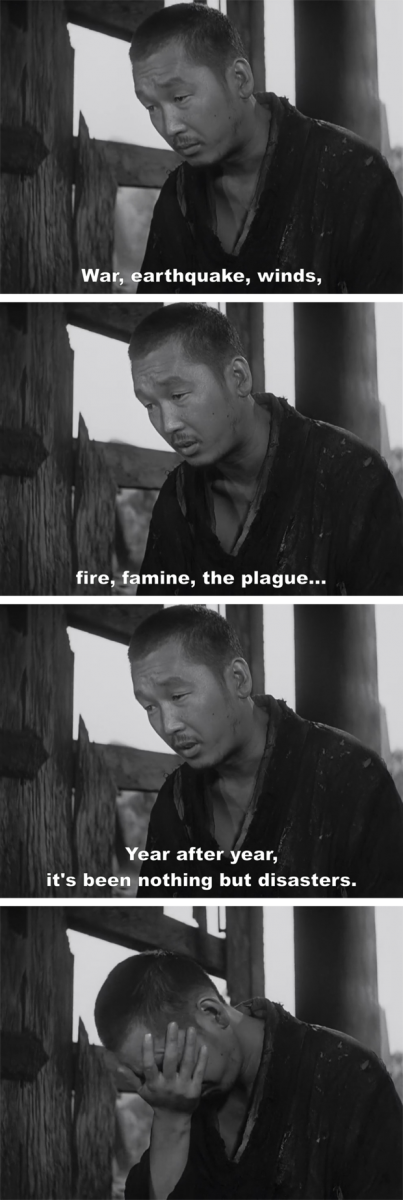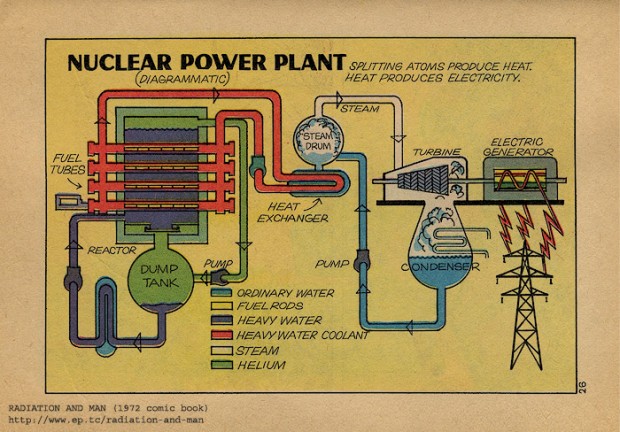An iconographic and text archive related to communication, technology and art.
☛ Radiation and man by the Canadian Nuclear Association, 1972, p. 26. Scanned and made available online by Ethan Persoff.
I first spotted this diagrammatic of a nuclear power plant via Modcult.
• • •
I remember I first heard about what would soon be known as the Tōhoku earthquake early in the day on Friday March 11, 2011. Pictures and video of the catastrophe were already spreading fast on the Internet. On the evening of the next day, I started getting confusing news about a “meltdown” occurring at one of Japan nuclear power plants. I briefly had access to FOX News: the coverage was disconcerting. The so-called “experts” analysis were by times hysterical. Most news source were repeating the same information: mainly that there was seldom information available.
Although it is well known today that the core of three nuclear reactors at the Fukushima Daiichi Nuclear Power Plant complex suffered a partial or total meltdown, this information was not immediately available on the days following the earthquake (it took more than a month for the situation to be re-classified from a level 4 to a level 7 event on the International Nuclear Event Scale).
In order to get accurate and reliable information about the incident in the earlier days of the disaster, one had to rely on other sources and channels than the ones usually provided by mainstream media. Bellum, a blog affiliated with The Stanford Review quickly issued some advice regarding the ways by which the crisis should be assessed:
- Ignore ambiguous statements from Japanese government officials. Pay attention to specific facts they provide because those will be verifiable in the future and will not be provided lightly.
- Presume the headlines are deceptive. Do not trust paraphrasing.
- Treat with skepticism any pronouncement from a “nuclear energy expert” if he/she is affiliated with an advocacy or agenda-driven organization.
- Most importantly, remember that very little information is actually known. Media organizations get scraps and tidbits, and these are recycled endlessly.
I spent the followings days trying to gather reliable facts from various official and unofficial sources. I especially remember the series of interviews geologist Evelyn Mervine (then a 5th-year PhD student in the MIT/Woods Hole Oceanographic Institution Joint Program) made with her father, Mark L. Mervine who was a nuclear engineer. The recording of those calm Skype conversations was more informative than the press releases made available by the Nuclear Energy Institute.
Below are all the entries I wrote on March and April 2011 regarding the Fukushima Daiichi nuclear disaster in particular and the Tōhoku earthquake in general.
- March 11, 2011: Japan Hit by a 9.0 Earthquake (March 11, 2011)
- March 13, 2011: Status of Japanese Nuclear Plants: Facts and Resources
- March 14, 2011: Status of Japanese Nuclear Plants: Facts and Resources [2]
- March 14, 2011: Japan, the 2011 Tōhoku Earthquake and Communication
- March 16, 2011: Status of Japanese Nuclear Plants: Facts and Resources [3]
- March 21, 2011: “Dark Spring” by Christoph Niemann, March 2011
- April 3, 2011: Disasters in Japan: Rashomon, 1950
The last entry was about a sequence in Akira Kurosawa’s Rashomon that seems to echo the distress of the Japanese population caught in the midst of an unprecedented catastrophe. It is reproduced below.

- By Philippe Theophanidis
- on
- ― Published in Communication, Technology
- Tagged: catastrophe, earthquake, environment, Fukushima, information, Japan, media, nuclear

